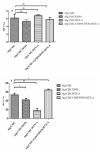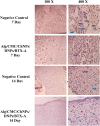Biological study of skin wound treated with Alginate/Carboxymethyl cellulose/chorion membrane, diopside nanoparticles, and Botox A
- PMID: 38413625
- PMCID: PMC10899239
- DOI: 10.1038/s41536-024-00354-2
Biological study of skin wound treated with Alginate/Carboxymethyl cellulose/chorion membrane, diopside nanoparticles, and Botox A
Abstract
A hydrogel-based wound dressing with desirable properties is necessary for achieving functional skin integrity post-injury. This study focuses on preparing a hydrogel using Alginate/Carboxymethyl cellulose (Alg/CMC) as a base material. To evaluate its regenerative effects on full-thickness wounds, diopside nanoparticles and Botulinum toxin A (BTX-A) were incorporated into the hydrogel along with chorion membrane. The diopside nanoparticles (DNPs) act as a proangiogenic factor, promoting proliferation and regulating inflammation, while the chorion membrane facilitates these processes. Additionally, BTX-A prevents scar formation and aids in wound closure. The nanoparticles and hydrogel were characterized using various techniques, and their cytocompatibility was assessed. In vivo studies and quantitative polymerase chain reaction analysis showed that wound area reduction was significant after two weeks of treatment with the Alg/CMC/ChNPs/DNPs/BTX-A hydrogel. Overall, this scaffold demonstrated potential for promoting tissue regeneration and new epithelization formation, making it a promising candidate for enhancing skin restoration in wound treatments.
© 2024. The Author(s).
Conflict of interest statement
The authors declare no competing interests.
Figures















References
-
- Schreml S, et al. The impact of the pH value on skin integrity and cutaneous wound healing. J. Eur. Acad. Dermatol. Venereol. 2010;24:373–378. - PubMed
-
- Khazaei, M., Alizadeh, M. & Rezakhani, L. Resveratrol‐loaded decellularized ovine pericardium: ECM introduced for tissue engineering. Biotechnol. Appl. Biochem. (2023). - PubMed
LinkOut - more resources
Full Text Sources

